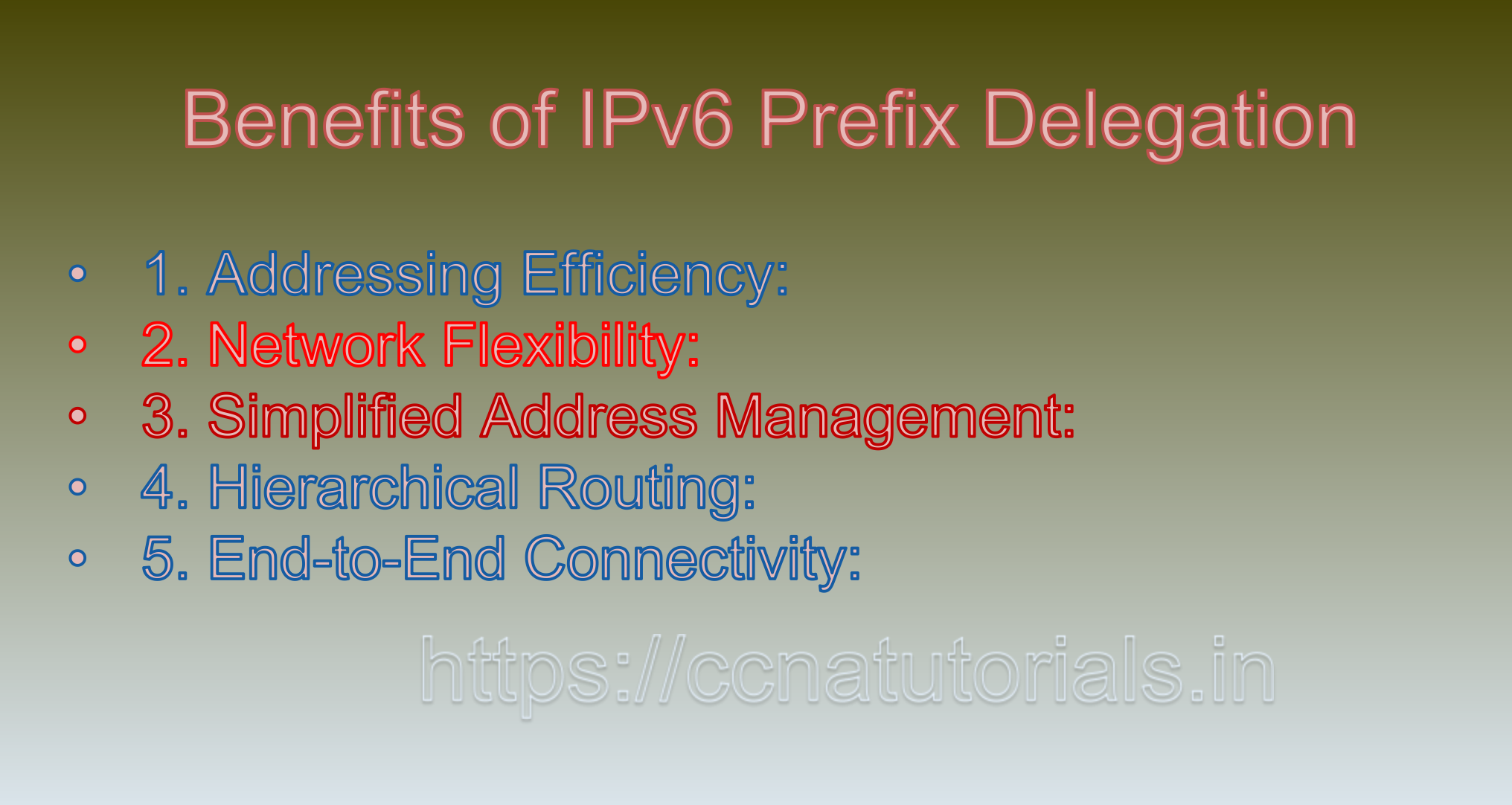Contents of this article
In this article, I describe IPv6 Prefix Delegation (IPv6 PD) in details. IPv6 Prefix Delegation (IPv6 PD) is a mechanism used in IPv6 networks to dynamically allocate IPv6 address prefixes to subnets or downstream networks. It plays a crucial role in enabling efficient and scalable IPv6 addressing and routing within service provider networks. In this explanation, we’ll delve into the concept of IPv6 Prefix Delegation, its significance, how it works, and its benefits.
1. Introduction to IPv6 Prefix Delegation:
IPv6 Prefix Delegation is a feature that allows Internet Service Providers (ISPs) to assign a range of IPv6 address prefixes to their customers, who can then further divide these prefixes into subnets as needed. It simplifies the process of managing address space distribution, making it easier for ISPs to allocate IP addresses and maintain routing efficiency.
2. The Need for IPv6 Prefix Delegation:
In IPv4 networks, the scarcity of IP addresses led to the widespread use of Network Address Translation (NAT) to conserve addresses. However, with IPv6’s vast address space, NAT is largely unnecessary, and every device can have a globally unique address. As a result, the emphasis shifts from address conservation to efficient routing and allocation.
IPv6 Prefix Delegation becomes crucial in scenarios where ISPs need to assign multiple prefixes to their customers, each representing a different subnet. For instance, a residential customer might need several subnets for different purposes, such as home devices, guest networks, and smart appliances.
3. How IPv6 Prefix Delegation Works:
IPv6 Prefix Delegation involves three main entities: the ISP, the customer edge router (CPE), and the customer’s internal network. Here’s how the process works:
1. ISP Configuration:
The ISP configures its routers to support Prefix Delegation and designates a range of IPv6 prefixes that can be delegated to customers.
2. CPE Request:
When a customer’s CPE router connects to the ISP’s network, it sends a Prefix Delegation Request to the ISP’s DHCPv6-PD (Prefix Delegation) server. This request includes information about the customer’s network topology and requirements.
3. Prefix Allocation:
The ISP’s DHCPv6-PD server evaluates the request and allocates an appropriate IPv6 prefix from the designated range. This prefix is assigned to the customer’s CPE router.
4. CPE Configuration:
The CPE router receives the delegated prefix and uses it to configure its own interfaces. It can then assign smaller subnets to various segments of the customer’s internal network.
5. Internal Network Configuration:
Within the customer’s internal network, routers use the received prefixes to configure interfaces on different subnets. Devices within those subnets can then obtain IPv6 addresses through stateless or stateful address autoconfiguration mechanisms.
4. Benefits of IPv6 Prefix Delegation:
– Addressing Efficiency: IPv6 Prefix Delegation allows efficient allocation of IPv6 prefixes, reducing the likelihood of address exhaustion and enabling the growth of interconnected networks.
– Network Flexibility: Customers can create and manage their subnets according to their specific requirements, providing flexibility in network design and architecture.
– Simplified Address Management: ISPs can easily assign and manage IPv6 address blocks for their customers without manual intervention, reducing operational complexity.
– Hierarchical Routing: By enabling hierarchical addressing, IPv6 Prefix Delegation supports efficient routing and aggregation, leading to better scalability and reduced routing table size.
– End-to-End Connectivity: IPv6 Prefix Delegation ensures that devices within customer networks can have direct, end-to-end connectivity without the need for NAT.
5. Challenges and Considerations in IPv6 Prefix Delegation (IPv6 PD):
– Proper Design: Careful design of the delegated prefix size is crucial to prevent unnecessary address wastage or inadequate address space for subnets.
– Security: Secure management of the delegation process is essential to prevent unauthorized parties from obtaining address prefixes.
– Configuration Complexity: Setting up and configuring IPv6 Prefix Delegation requires careful planning and coordination between ISPs and customers.

IPv6 Prefix Delegation (IPv6 PD):
IPv6 Prefix Delegation is a powerful mechanism that facilitates efficient and scalable IPv6 addressing within ISP networks. By allowing ISPs to dynamically allocate address prefixes to customers and enabling customers to manage subnets, IPv6 Prefix Delegation supports the growth of IPv6-connected networks and paves the way for a more connected and address-rich Internet ecosystem. As IPv6 adoption continues to expand, Prefix Delegation plays a critical role in ensuring the successful deployment of this next-generation Internet protocol. IPv6 Prefix Delegation (IPv6 PD) is a mechanism used to assign a range of IPv6 prefixes from an Internet Service Provider (ISP) to a customer, enabling the customer to create subnets and allocate IPv6 addresses within their network. Let’s explore IPv6 Prefix Delegation with some examples:
Scenario: Residential Internet Connection
Imagine you are a network administrator for a residential ISP providing IPv6 connectivity to your customers. You want to allocate IPv6 address prefixes to your customers so they can create multiple subnets within their homes.
1. ISP Configuration:
Your ISP configures its routers to support IPv6 Prefix Delegation and designates a pool of IPv6 prefixes that can be delegated to customers. Let’s say you have been assigned the IPv6 prefix `2001:db8:1000::/48` for delegation.
2. Customer Edge Router (CPE) Request:
A residential customer subscribes to your ISP’s service and connects their CPE router to your network. The CPE router sends a Prefix Delegation Request to your ISP’s DHCPv6-PD server, indicating that it needs an IPv6 prefix for its internal network.
3. Prefix Allocation:
Your ISP’s DHCPv6-PD server processes the request and allocates a specific prefix from the designated pool. Let’s say the DHCPv6-PD server assigns the prefix `2001:db8:1001::/56` to the customer’s CPE router.
4. CPE Configuration:
The customer’s CPE router receives the delegated prefix `2001:db8:1001::/56`. The CPE router then configures its internal interfaces using this prefix.
5. Internal Network Configuration:
Within the customer’s home network, the CPE router can allocate smaller subnets to different segments. For instance, it might create a subnet `2001:db8:1001:1::/64` for smart devices and another subnet `2001:db8:1001:2::/64` for guest devices.
Scenario: Small Business Network
Now let’s consider a small business that subscribes to your ISP’s IPv6 service and needs to configure multiple subnets for its various departments.
1. ISP Configuration:
Your ISP has a designated IPv6 prefix pool for business customers. Let’s say the ISP has `2001:db8:2000::/48` as the prefix pool for business IPv6 PD.
2. Customer Edge Router (CPE) Request:
The small business sets up its CPE router, which sends a Prefix Delegation Request to the ISP’s DHCPv6-PD server.
3. Prefix Allocation:
The ISP’s DHCPv6-PD server allocates a prefix from the business prefix pool, such as `2001:db8:2001::/56`, for the small business.
4. CPE Configuration:
The CPE router configures its internal interfaces with the delegated prefix `2001:db8:2001::/56`.
5. Internal Network Configuration:
The small business divides the allocated prefix into subnets for different departments. For example, it creates a subnet `2001:db8:2001:1::/64` for sales, `2001:db8:2001:2::/64` for marketing, and `2001:db8:2001:3::/64` for engineering.
Benefits and Considerations of IPv6 Prefix Delegation:
– Benefits: IPv6 Prefix Delegation allows ISPs to efficiently manage address allocation, enables hierarchical routing, and gives customers flexibility in subnetting for their internal networks.
– Considerations: Proper design of prefix sizes and secure management of the delegation process are crucial. Customers should be aware of how to configure their internal networks to utilize the delegated prefixes effectively.
Conclusion for IPv6 Prefix Delegation
IPv6 Prefix Delegation is a powerful tool that empowers ISPs and customers to make the most of IPv6’s expansive address space, enabling efficient network growth and seamless communication in both residential and business environments.






